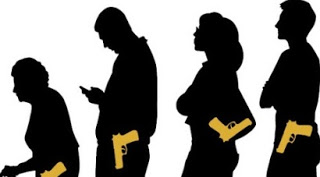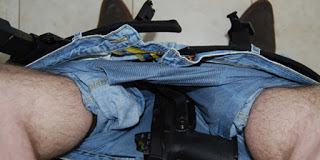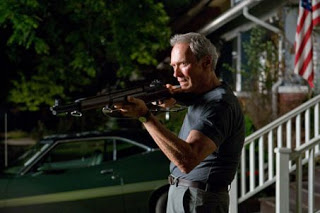I count myself very lucky that I have never had the opportunity present itself wherein I had to defensively pull a firearm from concealment to diffuse a situation. As they say, it is only a matter of time for anyone. The Old Man did tell me of an encounter he had in a side street of Birmingham earlier this this year when he was still mobile. Having just come back from, (I think), the Birmingham Public Library, he was walking down a five foot or so wide passageway that was created by a gap in two large municipal buildings. Not big enough for cars, but it did provide a decent enough place for foot traffic. As he walked down the path, he was approached by a younger gentleman who noticed that Mike had a hat on that read, in part, "All Lives Matter". I say in part because the portion that was written underneath was covered up, and said simply. "That's why I'm armed". Valuable information that the guy would have taken into consideration had he seen it. The kid, whom was guessed to be of reasonably athletic build and in his late teens to early twenties, saw the hat about 15 feet out and immediately changed his facial expression to stone cold hate.
When the two were just within striking distance, the kid changed his direction and punched at Mike. The blow was so angry and forceful, he threw the full force of weight into it and became unbalanced. Mike was able to just dodge the punch to his head and the attacker's kinetic energy carried him to the ground. Thugs, of either the fake or very real variety, are by nature not the most pleasant bunch, so when they telegraph their intentions it is best to capitalize on it. When Mike noticed a change in the guys demeanor, he had already started to reach in his front pocket to get a handle on the 380 Taurus. When the thug struck at him, he was able to step away, pull out the pistol and aim it at his attackers face. This did not entirely deter his assaulter from resuming the attack.
"It is going to be pretty sad day for your Mama when they have to pick your fucking brains off of the fucking wall after I shoot you", was the only thing that Mike could summon to say. The kid was still visibly enraged and started to rise. Fortunately for our would-be attacker, self-preservation took over and he deflated. Upon seeing that the lead taken from the kids pencil, Mike said, "Now git". Trayvon ran off in the direction he was originally going and Mike was able to continued going on his.
This was not the first time that he had to pull a pistol in Birmingham. I believe it was in the mid to late 90's he occupied in one of his favorite things to do, which was to sit in his car and read a news paper that he had just bought at a gas station. An older gentleman, that appeared to be homeless, approached his car from about 50 feet and said over and over, more loudly each time, "Give me 10 dollas". When the guy reached to about 10 feet out, Mike produced a Keltec P11 9mm with an extra magazine, and told him, "How about I give you eleven plus ten". Mr. Mugger made a surprisingly quick 180 degree turn and left without his 10 dollas.
Now before we get into the weeds with that the venerable small game round, the 22, (or any particular pet round) as the "be all, end all" self defense round, the author has this to consider:
"In a certain (fairly high) percentage of shootings, people stop their aggressive actions after being hit with one round regardless of caliber or shot placement. These people are likely NOT physically incapacitated by the bullet. They just don't want to be shot anymore and give up! Call it a psychological stop if you will. Any bullet or caliber combination will likely yield similar results in those cases. And fortunately for us, there are a lot of these "psychological stops" occurring. The problem we have is when we don't get a psychological stop. If our attacker fights through the pain and continues to victimize us, we might want a round that causes the most damage possible. In essence, we are relying on a "physical stop" rather than a "psychological" one. In order to physically force someone to stop their violent actions we need to either hit him in the Central Nervous System (brain or upper spine) or cause enough bleeding that he becomes unconscious. The more powerful rounds look to be better at doing this."
I contacted Mr. Eillifritz to see if I he could, perhaps, shed any more light on the subject or if he had altered his opinion in the years since he wrote the article. To my honor and delight, he is a regular reader and gave this very thoughtful response:
"After a few years, I am realizing that two additional factors come into play when determining how quickly an attackers stops after being shot.
One clear takeaway from the data is that we can argue about pistol calibers in perpetuity. What trumps them all are rifles and shotguns.
Makes you wonder why, if handguns are the overwhelming winner in firearm related deaths, that the Social Elites want your long guns so bad. You know...for the children.
I contacted Mr. Eillifritz to see if I he could, perhaps, shed any more light on the subject or if he had altered his opinion in the years since he wrote the article. To my honor and delight, he is a regular reader and gave this very thoughtful response:
"After a few years, I am realizing that two additional factors come into play when determining how quickly an attackers stops after being shot.
"The first is whether the attacker is shot by a cop or an armed citizen. A criminal knows that if he flees an armed citizen, he is likely to survive and not be arrested. The same does not hold true after being shot by a cop. The cop is going to continue the fight until the criminal is either incapacitated or arrested. That means criminals fight harder against cops than they do against armed citizens.
"Many of the 9mm and .40 shootings are police incidents. I think that leads to a potentially inflated number of rounds taken by criminals in those incidents.
"The other factor is the speed at which the rounds can be fired. Most people can fire a 9mm faster than they can fire a .45. In scenarios that are psychological stops (not physical incapacitations). it takes a certain period of time for the criminal to recognize that he has been shot and either flee or comply.
"For the sake of argument, let's say that period of time is 3 seconds. In three seconds, I am likely to hit you with more rounds if I am shooting a 9mm than if I am shooting a .45. In reality, one bullet from either caliber would have likely caused the same reaction. The number of hits ends up more being a function of how quickly the shots can be fired rather than how effective the cartridge is.
"I think these are the prime reasons why the .22 and .25 did so well. Both are primarily shot by armed citizens. The criminals got hit with one shot and fled. Also the .22 mini revolvers and tiny autos tend to be slower to fire than a full sized auto pistol. They are also more prone to malfunctions. Those factors may be the reason that those particular calibers required such a small number of shots to stop the attack.
"Overall, that's about the only thing I can add to the information that I wrote back in 2011. If anything, it leads me to believe that there is even LESS difference between all those cartridges than my original study determined."
I could not find definitive numbers, one way or the other, of instances where the mere presence of a firearm brought about a peaceful resolution to the crime. However, I think it is fairly self-evident that the presence of a firearm, any firearm, is usually enough to make an attacker question their life choice. If you are going to choose to carry, and I sincerely hope you are even if a little state funded bureaucrat is telling you that you cannot. But if you choose to carry, the Rawlesian philosophy of ATGATT, or All The Gear, All The Time, would mean you carry the weapon plus spare mags. All. The. Time. At the very least it just might save you 10 dollas.
One clear takeaway from the data is that we can argue about pistol calibers in perpetuity. What trumps them all are rifles and shotguns.
Makes you wonder why, if handguns are the overwhelming winner in firearm related deaths, that the Social Elites want your long guns so bad. You know...for the children.
Get off my lawn.



15 comments:
Excellent.
Glad you reached out to Greg on this. His thoughts on the 9mm and .40 stats are valuable, and probably right on.
they want the rifles because they provide the ability to exert deadly force over a longer distance than a hand gun, and the possibility of the freedom fighter to escape and strike again..
Dr.D
A 22 in the eye is better than a 50bmg flying by. It matters little what you carry/use as long as you have the ability to place the bullet properly. I don't care how much armor you enemy wears, there is always a soft place to tag your foe. Killed many a deer for the table with a 22 as a kid, learned long ago it's placement, not hype.
B-4
I still firmly believe that shot placement is the qualifier. Shoot me in the foot with a .45 and I shoot you in the face with a 9mm and I win.
"Hits Count" -- Project Appleseed
The USSA knows that rounds from rifles and shotguns can usually penetrate the soft body armor of their goons, and thus ruin the dedication of the remaining goons, who'll demand expensive hard armor. That is a reason for them to try and steal privately owned long guns.
LOVE the Bugs and Daffy cartoon!!! LOLOLOLOL....PERFECTLY adapted to the, "Never Ending Story/Debate."
Tom Givens at Rangemaster does a great presentation based on data he's collected from 65 shots-fired defensive gun uses that his students have amassed over the years. (It was 65 DGUs as of 2012, I'm sure it's more now). The presentation is well worth seeing btw because it covers stats on what happened when private armed citizens were attacked, actual data not theory.
With respect to the question of what handgun caliber is most effective, Givens' dataset offers evidence that supports the same conclusions that you and Greg Ellifritz state.
Givens states it as if you hit "here" (indicates pie plate-sized circle around the upper chest) with a centerfire 38/9mm/40/45, it's going to stop the attack.
Another point Givens makes that you guys also cover is to not confuse "average" gunfight with what you need to be prepared to handle. "On average", one of the Givens' students' defensive gun use used about 3 rounds at a distance of 3 feet, and was over in 3 seconds or less. But, that's an average. One DGU used 11 rounds which was all the defender had in his gun, and he would have used more if he'd had it, and another DGU took place at 25 yards.
I think the point is similar to the one you guys make about don't assume 100% that the same circumstances will apply to your citizen's defensive gun use in stopping an attack vs. data reported for uniformed LEO encounters which may differ in what happens and in how hard the attacker fights before stopping his attack.
Re Tom Givens, everything he said made sense to me (private citizen guy) but you're exactly in agreement with him when you say that if you're going to carry, then carry everywhere.
The way Givens puts it, "You don't get to decide when you need the gun, someone else gets to decide that for you. But, you DO get to decide if the gun will be with you when you need it". That is, if you do carry everywhere, you will have the tool when the need is there for it.
Out of the 65 former students who'd trained under Tom Givens, he said that 63 of the 65 prevailed against their attackers. Of the two former students who did not prevail against their attackers, neither of them was armed when they were attacked. Carry, if possible.
I've been following this 'debate' for 40+ years, ever since the Relative Incapacitation Index came out. There have been numerous studies done during that time such as the long term study done by Sgt. Evan Marshall (Detroit PD IIRC) regarding 'one shot stops' (consistent with the 'psychological/physiological' concept). His primary conclusion, also consistent with Givens et al, was that bullet placement is the primary factor. Of course in order to 'place' a bullet one has to be carrying in the first place.
Final note, even Jeff Cooper acknowledged late in life that a solid hit with a small caliber was far superior to a miss with a .45.
Excellent article. I have long said that the first rule of a gun fight is: Have a gun. The second rule is never have a fair fight. As said before, if you find yourself in a fair fight, your tactics suck.
Sounds like a bunch of tall tales to me.
Caliber's only part of the equation. Firearm reliability and shooter proficiency are others. Know your firearm's fit and function, and practice, practice, practice.
Might as well drop .22 caliber from the debate. Still hard to find ammo for 'em unless you stalk gun shows or order online. I've come to reserve use of my .22 stash for initial training of new shooters, or going to a range with youngsters.
I only use ammo routinely that I can routinely replenish.
I think that of particular pertinence is that most DGUs do not involve firing at all, merely displaying the weapon and the determination to not be victimized. Speaking of "psychological stops" takes on a certain ironic quality if we don't consider these incidents.
And, psychologically speaking, size matters a lot when comparing the effect of looking down the business end of a .45 compared to a .22, or anything in between. But the felt quality of the eyes looking over that barrel matter even more.
That's why I stress your own psychology, your own commitment to pull the trigger on whatever weapon you're carrying before allowing yourself to become a statistic, over other concerns. And the fact of the matter is that most people are going to be more willing to pull the trigger on a .22 than a .45, especially after becoming more experienced with both.
But there is a point of diminishing returns...you want to convince a potential adversary that just walking (or running) away is a real possibility, after all. The size of the muzzle can make a decisive difference between two slightly different shades of "twitch wrong and this goes in your eye".
That makes "best caliber" very personal and subjective indeed, it varies for the same person on different days or different minutes of the same hour. I still recommend .22 for people who are yet not fully comfortable with the thought of fatally shooting someone, precisely because I don't pretend that it is more likely to instantly kill anyone. It's not a non-lethal, or even particularly 'less-lethal' (in the legal sense) weapon, but it's easier to both be and appear willing to shoot someone with one. Until you're sufficiently ready to pull the trigger on a higher caliber weapon, that matters.
For myself, I passed the point of being willing to pull the trigger on any available class of weapon a long time ago...which is why I focus more on getting other people, in as great quantities as possible, to pull their triggers.
.22LR tends to be a lesser choice in part because rimfire cartridge ignition reliability in smaller pistols tend to be poorer compared to centerfire cartridges in small pistols.
RSR
Post a Comment